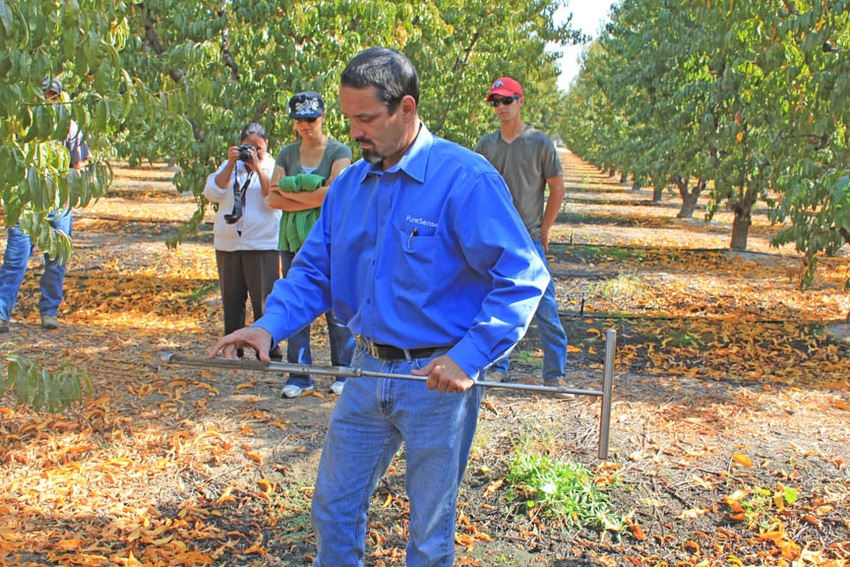November 14, 2013

Getting even distribution of water to the roots of peach trees in a given orchard can mean a combination of high tech wizardry and low tech, hands-on tweaking.
That was well demonstrated at Fresno State University in an irrigation seminar that showcased the use of probes that go deep into the ground and can provide data over cell phones or laptops.
But those probes shared the stage with less sophisticated tools that included pliers and “goof plugs” that are used for irrigation lines after a test with a pressure gauge.
Speakers at the Center for Irrigation Technology workshop told how a simple adjustment to valves in an orchard on the campus farm – taking just minutes -- brought an 8 percent improvement in the even distribution of irrigation water, moving the uniformity percentage from 84 percent to 92 percent.
That means water savings and more efficient water use.
The initials “DU” were tossed about freely. That’s not a reference to Ducks Unlimited but to “Distribution Uniformity,” a measure of how evenly water soaks into the ground across a field during irrigation.
Kaomine Vang, CIT project manager, and Bill Green, education manager of the center’s advanced pumping efficiency program, talked of some of the challenges in a 12-acre orchard on campus where July Flame Peaches have been grown for about a decade.
They told how tests were conducted to show variability in water pressure on parts of the orchard that showed that simply turning the knobs on valves that deliver water to the orchard greatly improved efficiency of the system.
The two said the problem was that someone was turning two pressure regulating valves open or closed and had opened one of them all the way. Green said it might be wise to remove the handles once adjustments are made.
Both men said that challenges in the orchard include the fact that water that comes from a canal is low in pH and does not seep deeply into the sandy soil. That has meant some standing water that draws the attention of mosquito abatement officials, they said.
Green said some efforts have been made to improve permeability by adding limestone and gypsum to the soil.
David Jamison, senior agronomist with PureSense in Fresno, explained how moisture sensors are buried in the soil as deep as 5 feet to determine moisture levels that are shown on graphs. He also used a metal soil probe that he thrust into the soil to check the depth of moisture.
Jamison said it is important to survey the field and irrigation layout before putting the automatic sensors in place, taking into account soil types, commodity differences and other issues.
Irrigation scheduling
He said new technology enables the use of irrigation systems to better understand infiltration rates and to convert the number of hours used to the amount of applied water.
Irrigation scheduling draws on information from a variety of sources, including historical data and software that includes that provided through the university with its Wateright program.
Jamison said PureSense makes available a free software tool for irrigation scheduling. He said PureSense is not alone in providing help on distribution uniformity, noting there are private consultants and public agencies that can help.
All of the speakers said system maintenance is important, and that means filtration maintenance, checking for leaks and, flushing the system. Not doing so can mean lost money through inefficiencies in delivery of water or nutrients if a system is also used for fertigation.
Green explained that the highest pressure readings can be expected closest to the water source. Vang said guidelines from the Irrigation Training Research Center at California Polytechnic State University, San Luis Obispo are used to evaluate an irrigation system.
That’s where the goof plugs, pliers and other tools enter the picture. A punch is used to open a hole where a pressure gauge can be inserted. A reading is taken, adjustments are made and the gauge is withdrawn. Then a goof plug is inserted.
Vang and Green showed that measurements were taken at six locations -- near the water source, midway to the end of irrigation lines and furthest from the source. They found considerable variability in pounds per square inch at the different sites, as much as a 10 PSI difference in places.
They also showed how to check emitters to determine flow levels, using a bucket to catch water for two minutes and then pouring the water into a measuring container.
Jamison also talked briefly of developments in recent years to improve cherry production in the San Joaquin Valley where the number of chilling hours is critical.
He said some growers are using overhead evaporative cooling to boost the number of hours in order to gain a market advantage by encouraging earlier fruit production that can command a higher price.
Jamison said the past two cherry harvests in the Valley have been late, resulting in lower prices for many growers. He said it is important to take into account that warmer temperatures during the day can reverse effects of overnight chilling.
Cherries are not the only crop that can benefit from evaporative cooling. He said those measures are also being used in kiwis, applies and grapes.
Aric Olson, president of Jain Irrigation Inc., said his company has been using micro jets to cool vineyards in Napa Valley field trials for three years and is close to rolling out a new product for that.
More from Western Farm Press
The myth of the aging US farmer
About the Author(s)
You May Also Like




